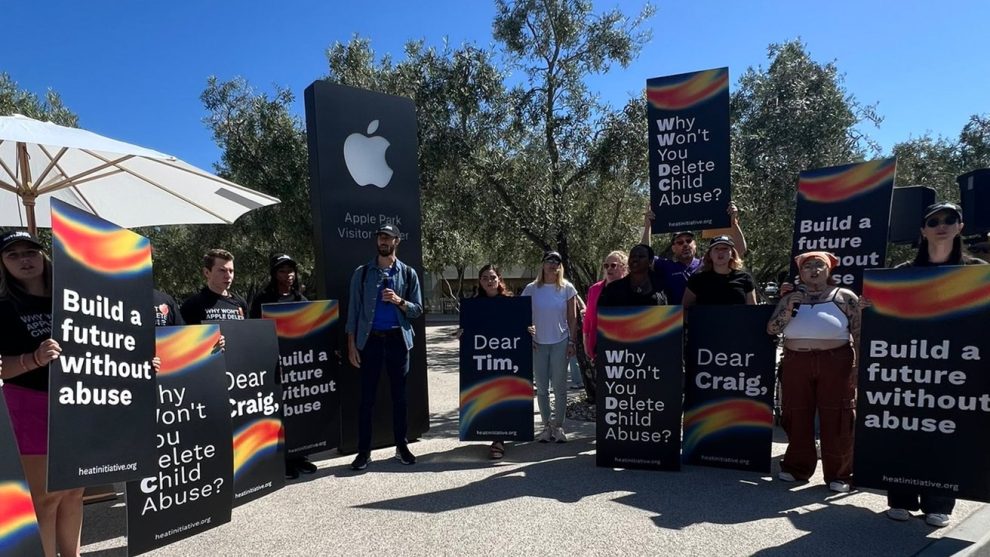Tensions escalated at Apple Park today as child safety advocates, rallying under the banner of the Heat Initiative, descended upon Apple’s headquarters. Their mission: to demand the reinstatement of Apple’s controversial CSAM (Child Sexual Abuse Material) detection tools, which were discontinued in September 2021. The protest underscores the ongoing ethical debate surrounding these technologies, pitting child protection against concerns over user privacy and potential misuse.
Advocates’ Perspective: The Urgent Need for CSAM Detection
The Heat Initiative and allied organizations staunchly advocate for the reinstatement of Apple’s CSAM detection tools, citing several critical reasons:
- Combatting Child Exploitation: CSAM detection tools are designed to identify known images of child sexual abuse stored in iCloud Photos. Advocates argue that reinstating these tools is essential for promptly reporting such materials to authorities, crucial for rescuing victims and prosecuting perpetrators.
- Corporate Responsibility: As a leader in the tech industry, Apple is seen by advocates as having a responsibility to implement robust measures to protect vulnerable users, especially children, who may be using their devices.
- Ethical Imperative: Advocates frame the issue as a moral imperative, prioritizing child safety over potential privacy concerns. They argue that some form of detection technology is necessary to combat the proliferation of CSAM effectively.
Opposition: Privacy and Potential Misuse Concerns
However, Apple’s decision to discontinue its CSAM detection tools was met with significant criticism and skepticism from privacy advocates and others within the tech community:
- Privacy Violations: Critics contend that scanning users’ personal photos for CSAM crosses a critical privacy boundary. They argue that such technologies could potentially be abused for surveillance or censorship purposes.
- False Positives: Concerns persist over the accuracy of detection algorithms, with fears that legitimate content could be mistakenly flagged as CSAM, leading to unwarranted scrutiny or harm to users.
- Government Overreach: There are apprehensions that government agencies might pressure tech companies like Apple to expand the use of detection tools beyond CSAM, raising broader concerns about digital surveillance and privacy rights.
Apple’s Response and Future Directions
Apple’s decision to halt the rollout of CSAM detection tools in 2021 reflects their acknowledgment of the complex ethical and practical challenges involved:
- Commitment to Child Safety: Despite discontinuing CSAM detection, Apple remains committed to enhancing child safety through other means, such as user-friendly reporting mechanisms and collaboration with law enforcement.
- Exploring Alternatives: The company continues to explore alternative methods to address CSAM, emphasizing the importance of balancing technological innovation with user privacy and security.
Moving Forward: Finding Common Ground
The rally at Apple Park underscores the need for ongoing dialogue and collaboration among stakeholders to find viable solutions that prioritize both child safety and user privacy:
- Industry Collaboration: Tech companies, child safety advocates, privacy experts, and policymakers must collaborate to develop effective, privacy-respecting strategies for combating CSAM distribution.
- Legislative Guidance: Clear and balanced legislative frameworks are essential to guide the responsible development and implementation of technologies aimed at detecting and preventing CSAM.
- Public Awareness: Educating the public about the risks of CSAM and empowering individuals to recognize and report abusive content is crucial in creating a safer online environment.
Conclusion: A Call to Action
The protest at Apple Park serves as a poignant reminder of the stakes involved in leveraging technology to protect vulnerable populations. By navigating the complexities of privacy, ethics, and technological capabilities, stakeholders can work together to foster a digital landscape where safety and privacy coexist harmoniously.
As the debate evolves, the challenge remains to forge solutions that effectively combat CSAM while upholding fundamental rights and values. Ultimately, collective action is essential to ensure that technology serves as a force for good in safeguarding the most vulnerable among us.
















Add Comment